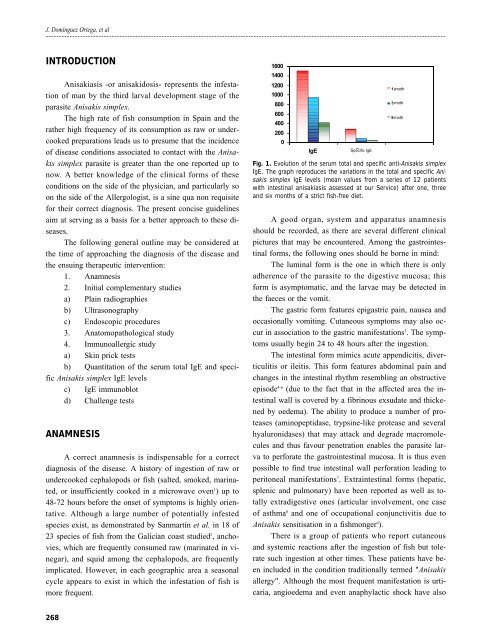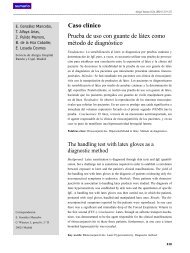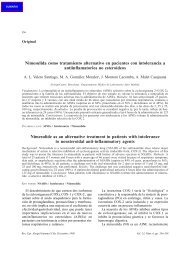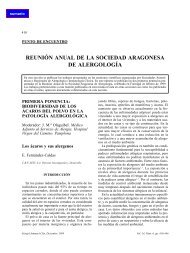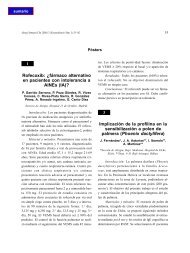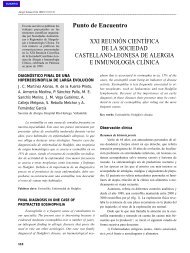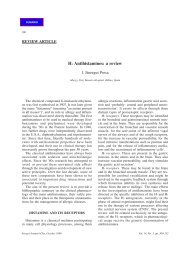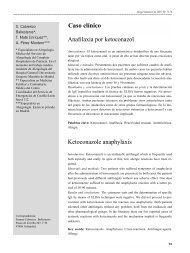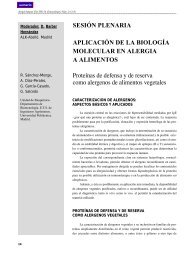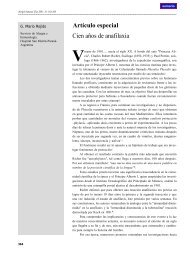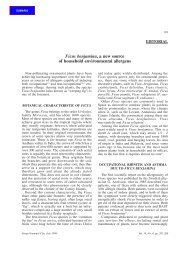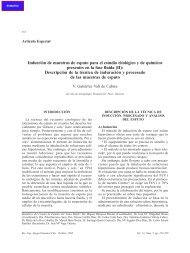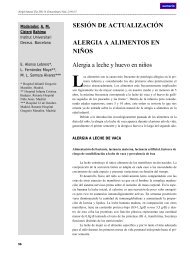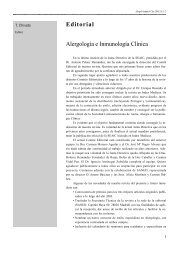Guidelines in pathology induced by Anisakis Original Article
Guidelines in pathology induced by Anisakis Original Article
Guidelines in pathology induced by Anisakis Original Article
Create successful ePaper yourself
Turn your PDF publications into a flip-book with our unique Google optimized e-Paper software.
J. Domínguez Ortega, et al<br />
INTRODUCTION<br />
Anisakiasis -or anisakidosis- represents the <strong>in</strong>festation<br />
of man <strong>by</strong> the third larval development stage of the<br />
parasite <strong>Anisakis</strong> simplex.<br />
The high rate of fish consumption <strong>in</strong> Spa<strong>in</strong> and the<br />
rather high frequency of its consumption as raw or undercooked<br />
preparations leads us to presume that the <strong>in</strong>cidence<br />
of disease conditions associated to contact with the <strong>Anisakis</strong><br />
simplex parasite is greater than the one reported up to<br />
now. A better knowledge of the cl<strong>in</strong>ical forms of these<br />
conditions on the side of the physician, and particularly so<br />
on the side of the Allergologist, is a s<strong>in</strong>e qua non requisite<br />
for their correct diagnosis. The present concise guidel<strong>in</strong>es<br />
aim at serv<strong>in</strong>g as a basis for a better approach to these diseases.<br />
The follow<strong>in</strong>g general outl<strong>in</strong>e may be considered at<br />
the time of approach<strong>in</strong>g the diagnosis of the disease and<br />
the ensu<strong>in</strong>g therapeutic <strong>in</strong>tervention:<br />
1. Anamnesis<br />
2. Initial complementary studies<br />
a) Pla<strong>in</strong> radiographies<br />
b) Ultrasonography<br />
c) Endoscopic procedures<br />
3. Anatomopathological study<br />
4. Immunoallergic study<br />
a) Sk<strong>in</strong> prick tests<br />
b) Quantitation of the serum total IgE and specific<br />
<strong>Anisakis</strong> simplex IgE levels<br />
c) IgE immunoblot<br />
d) Challenge tests<br />
ANAMNESIS<br />
A correct anamnesis is <strong>in</strong>dispensable for a correct<br />
diagnosis of the disease. A history of <strong>in</strong>gestion of raw or<br />
undercooked cephalopods or fish (salted, smoked, mar<strong>in</strong>ated,<br />
or <strong>in</strong>sufficiently cooked <strong>in</strong> a microwave oven 1 ) up to<br />
48-72 hours before the onset of symptoms is highly orientative.<br />
Although a large number of potentially <strong>in</strong>fested<br />
species exist, as demonstrated <strong>by</strong> Sanmartín et al. <strong>in</strong> 18 of<br />
23 species of fish from the Galician coast studied 2 , anchovies,<br />
which are frequently consumed raw (mar<strong>in</strong>ated <strong>in</strong> v<strong>in</strong>egar),<br />
and squid among the cephalopods, are frequently<br />
implicated. However, <strong>in</strong> each geographic area a seasonal<br />
cycle appears to exist <strong>in</strong> which the <strong>in</strong>festation of fish is<br />
more frequent.<br />
268<br />
1600<br />
1400<br />
1200<br />
1000<br />
800<br />
600<br />
400<br />
200<br />
0<br />
IgE IgE esp<br />
Specific IgE<br />
1 mes moth<br />
3 meses moth<br />
6 meses moth<br />
Fig. 1. Evolution of the serum total and specific anti-<strong>Anisakis</strong> simplex<br />
IgE. The graph reproduces the variations <strong>in</strong> the total and specific <strong>Anisakis</strong><br />
simplex IgE levels (mean values from a series of 12 patients<br />
with <strong>in</strong>test<strong>in</strong>al anisakiasis assessed at our Service) after one, three<br />
and six months of a strict fish-free diet.<br />
A good organ, system and apparatus anamnesis<br />
should be recorded, as there are several different cl<strong>in</strong>ical<br />
pictures that may be encountered. Among the gastro<strong>in</strong>test<strong>in</strong>al<br />
forms, the follow<strong>in</strong>g ones should be borne <strong>in</strong> m<strong>in</strong>d:<br />
The lum<strong>in</strong>al form is the one <strong>in</strong> which there is only<br />
adherence of the parasite to the digestive mucosa; this<br />
form is asymptomatic, and the larvae may be detected <strong>in</strong><br />
the faeces or the vomit.<br />
The gastric form features epigastric pa<strong>in</strong>, nausea and<br />
occasionally vomit<strong>in</strong>g. Cutaneous symptoms may also occur<br />
<strong>in</strong> association to the gastric manifestations 3 . The symptoms<br />
usually beg<strong>in</strong> 24 to 48 hours after the <strong>in</strong>gestion.<br />
The <strong>in</strong>test<strong>in</strong>al form mimics acute appendicitis, diverticulitis<br />
or ileitis. This form features abdom<strong>in</strong>al pa<strong>in</strong> and<br />
changes <strong>in</strong> the <strong>in</strong>test<strong>in</strong>al rhythm resembl<strong>in</strong>g an obstructive<br />
episode 4-6 (due to the fact that <strong>in</strong> the affected area the <strong>in</strong>test<strong>in</strong>al<br />
wall is covered <strong>by</strong> a fibr<strong>in</strong>ous exsudate and thickened<br />
<strong>by</strong> oedema). The ability to produce a number of proteases<br />
(am<strong>in</strong>opeptidase, tryps<strong>in</strong>e-like protease and several<br />
hyaluronidases) that may attack and degrade macromolecules<br />
and thus favour penetration enables the parasite larva<br />
to perforate the gastro<strong>in</strong>test<strong>in</strong>al mucosa. It is thus even<br />
possible to f<strong>in</strong>d true <strong>in</strong>test<strong>in</strong>al wall perforation lead<strong>in</strong>g to<br />
peritoneal manifestations 7 . Extra<strong>in</strong>test<strong>in</strong>al forms (hepatic,<br />
splenic and pulmonary) have been reported as well as totally<br />
extradigestive ones (articular <strong>in</strong>volvement, one case<br />
of asthma 8 and one of occupational conjunctivitis due to<br />
<strong>Anisakis</strong> sensitisation <strong>in</strong> a fishmonger 9 ).<br />
There is a group of patients who report cutaneous<br />
and systemic reactions after the <strong>in</strong>gestion of fish but tolerate<br />
such <strong>in</strong>gestion at other times. These patients have been<br />
<strong>in</strong>cluded <strong>in</strong> the condition traditionally termed "<strong>Anisakis</strong><br />
allergy". Although the most frequent manifestation is urticaria,<br />
angioedema and even anaphylactic shock have also


